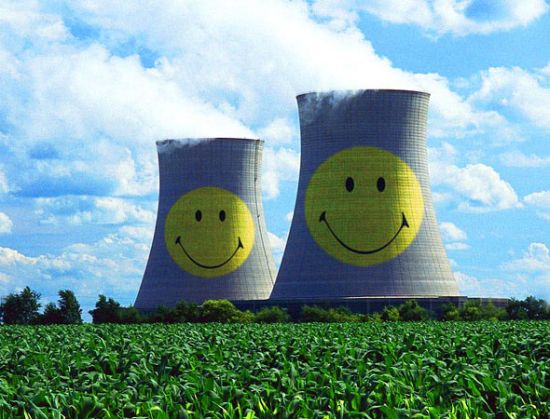Progress!
#21
Boost Pope


Thread Starter
iTrader: (8)
Join Date: Sep 2005
Location: Chicago. (The less-murder part.)
Posts: 33,020
Total Cats: 6,588
Irony:
My e-bike thread turned into a debate about nuclear power.
My nuclear power thread turned into a debate about e-bikes.
Honestly, this sounds a lot like where I live. Very little in the way of public transit, tons of freeway commuting, and no "downtown" area per se.
I'm not familiar with Overland Park, KS from a first-hand perspective, but judging from a quick Google Maps search, it does seem to have a great number of roads which are not Interstate highways, though I can certainly appreciate the inconvenience posed by the limited number of river crossings available if you are commuting towards the north.
So apart from the fact that it would take longer than 18 minutes, I can't imagine why you couldn't do this on a bike.
Don't get me wrong: I'm not judging you. I'm a car guy. I love owning cars, modifying cars, and driving cars. I sometimes drive purely for the enjoyment value, with no specific purpose or destination. I have no problem with your decision to drive a vehicle which you own outright for your daily commute, regardless of the monetary costs or the political, social and environmental harm caused by that choice. You have the right to own and drive a military-derived truck outfitted with a Chrysler V8 engine which gets 13 MPG to and from the office every single day, and I fully support this.
My e-bike thread turned into a debate about nuclear power.
My nuclear power thread turned into a debate about e-bikes.
I'm not familiar with Overland Park, KS from a first-hand perspective, but judging from a quick Google Maps search, it does seem to have a great number of roads which are not Interstate highways, though I can certainly appreciate the inconvenience posed by the limited number of river crossings available if you are commuting towards the north.
So apart from the fact that it would take longer than 18 minutes, I can't imagine why you couldn't do this on a bike.
Don't get me wrong: I'm not judging you. I'm a car guy. I love owning cars, modifying cars, and driving cars. I sometimes drive purely for the enjoyment value, with no specific purpose or destination. I have no problem with your decision to drive a vehicle which you own outright for your daily commute, regardless of the monetary costs or the political, social and environmental harm caused by that choice. You have the right to own and drive a military-derived truck outfitted with a Chrysler V8 engine which gets 13 MPG to and from the office every single day, and I fully support this.
#23
Elite Member
iTrader: (11)
Join Date: Jun 2007
Location: Overland Park, Kansas
Posts: 5,360
Total Cats: 43

Google Bicycle directions says it would take me roughly 55 - 70 minutes by bicycle. Think another issue I'd have is security while I was working. Doubt my company would let me keep the bike in my office..
Yikes. From the house in Grandview I just bought, 2 hours each way..
#24
Cpt. Slow

iTrader: (25)
Join Date: Oct 2005
Location: Oregon City, OR
Posts: 14,178
Total Cats: 1,129
How many miles on a road travelable by bike? If you can get their in a car door to door in 18 minutes, I can't see how a bike would be 50 minutes more, unless that's all at freeway speeds.
My current commute is as much highway as I can do, 19 miles, and 31 minutes.
A bicycle route is 16.7 miles, and if you can average 15-20 mph like joe said, that's only 57 minutes.
Sorry, I'm bored at work.
My current commute is as much highway as I can do, 19 miles, and 31 minutes.
A bicycle route is 16.7 miles, and if you can average 15-20 mph like joe said, that's only 57 minutes.
Sorry, I'm bored at work.
#25
Elite Member
iTrader: (11)
Join Date: Jun 2007
Location: Overland Park, Kansas
Posts: 5,360
Total Cats: 43
How many miles on a road travelable by bike? If you can get their in a car door to door in 18 minutes, I can't see how a bike would be 50 minutes more, unless that's all at freeway speeds.
My current commute is as much highway as I can do, 19 miles, and 31 minutes.
A bicycle route is 16.7 miles, and if you can average 15-20 mph like joe said, that's only 57 minutes.
Sorry, I'm bored at work.
My current commute is as much highway as I can do, 19 miles, and 31 minutes.
A bicycle route is 16.7 miles, and if you can average 15-20 mph like joe said, that's only 57 minutes.
Sorry, I'm bored at work.
#26
A thought regarding pedaling to work. How many of you have shower/changing rooms/lockers at work? I break into a sweat just looking at my bike.
#27
Elite Member
iTrader: (11)
Join Date: Jun 2007
Location: Overland Park, Kansas
Posts: 5,360
Total Cats: 43
Actually, this doesn't surprise me too much since they're tied together. Not just because electric, but due to the potential increased demand for power of e-transportation. Which brings up another issue...can our powergrid actually handle a significant increase in demand from, oh, say, 10% of daily commuters switching to plug-in vehicles?
A thought regarding pedaling to work. How many of you have shower/changing rooms/lockers at work? I break into a sweat just looking at my bike.
A thought regarding pedaling to work. How many of you have shower/changing rooms/lockers at work? I break into a sweat just looking at my bike.
This is something I would actually consider if I had access to changing / shower facilities at the office. Except for the fact that I'd have to get up about now (3am) to get ready for work...
#28
Boost Pope


Thread Starter
iTrader: (8)
Join Date: Sep 2005
Location: Chicago. (The less-murder part.)
Posts: 33,020
Total Cats: 6,588
It's a bit of a ludicrous example, but a couple of years ago Top Gear did an economy test in which they put both a Prius and BMW M3 onto the test track and ran ten laps. The Prius was driven in typical fashion as though it were being used to set a laptime, while the M3 was driven behind it at precisely the same speed- matching the Prius' performance exactly without overtaking it. The Prius returned 14.3 US MPG, while the M3 delivered 16.1 MPG.
Silly, I admit.
I honestly have no idea.
Both the US and Germany experimented with conventional Thorium reactors in the 60s and 70s, using a mix of Thorium and either U233 or U235 as the neutron source. They worked, but we seemed to lose interest, and they've all since been shut down. We apparently preferred to stick with the tried-and-true designs. It's a justifiable position, given that we've gotten pretty good and building and maintaining designs like the PWR and BWR.
India, which is sitting on a huge pile of thorium, has expressed some interest. They've got one 300MWe AHWR fast-breeder under construction at present, with five more planned. Makes sense, given their experience with the CANDU design.
In all of these designs, however, uranium is still used. Thorium, by itself, cannot sustain a reaction.
One of the most innovate reactor concepts which I have read about lately actually takes advantage of this fact. It's called a sub-critical reactor, and uses a fuel load comprised entirely of material (such as thorium) which, by itself, would be incapable of sustained fission. Instead, the reactor requires an external source of kick-start energy, which usually consists of a large accelerator which is used to shoot a stream of protons at the thorium, causing them to release neutrons and thus achieve criticality.
The most interesting feature of this system is that it is absolutely, 100% incapable of either a power excursion or accidental re-criticality.
A power excursion is what caused the Chernobyl explosion. In any self-sustaining reactor, there is a theoretical possibility that the reactor power may increase all by itself. In water-moderated reactors, this cannot happen unless the control rods are accidentally withdrawn, which has actually happened three times; once in 1961 at the SL-1 experimental reactor in Idaho (a plug actually shot out the top of the reactor and impaled a dude from groin to shoulder, pinning him to the ceiling- the only fatal reactor accident in the history US nuclear power),
once in 1968 aboard the Soviet submarine K-140 while the sub was in a yard for maintenance and the engineers hooked up the rod drive backwards, and again in 1985 aboard Soviet submarine K-314 as it, too, was undergoing yard maintenance and some retard pulled the lid off the reactor vessel with the rods still attached. (The Soviets had a long history of blowing up their own submarines. It's not pretty.)
At any rate, the reason that a rod-position excursion can't happen in a subcritical, accelerator-driven reactor is that there are no control rods in the first place. Power is modulated by varying the intensity of the accelerator beam. More beam energy = more proton bombardment.
So, what's typically the first thing that happens in any really serious nuclear accident? The power goes out. (In fact, this was the initiating event at both Fuku and Chernobyl.) If there's one thing a particle accelerator can't do without power, it's accelerate particles. So then the power goes out, the beam goes dark. Immediately. No active systems, no pressure accumulators, no waiting for rods to fall into place under the force of gravity. The sucker just turns OFF.
Same goes for Fuku-style accidents. One of the big concerns after the meltdowns occurred was re-criticality. In other words, once the fuel had melted and fallen to the bottom of the vessel, everyone was freaking out that it might spontaneously start up again. Absolutely, 100% impossible in a thorium-only system. No beam, no fission, regardless of what shape the fuel is in.
There are some downsides. Reactors of this design typically don't operate in water- they require either sodium or lead as their coolant. Molten metal sounds kind of scary, though it has the advantage of being able to operate at atmospheric pressure. The bummer is that if you ever let the lead cool down too much, you are now the proud owner of a gigantic, reactor-shaped block of solid lead. Sodium is a tad more forgiving in this regard, although pure sodium makes the word "flammable" seem inadequate. Remember the demonstration where your high school chemistry teacher dropped a tiny little chunk of sodium into a bowl of water? Multiply that by several million.
#29
Boost Pope


Thread Starter
iTrader: (8)
Join Date: Sep 2005
Location: Chicago. (The less-murder part.)
Posts: 33,020
Total Cats: 6,588
The demand for electrical power is not a constant- it tends to follow a curve throughout the day.
There there is very little demand late at night and early in the morning. As people wake up and start taking showers and brewing coffee, the demand starts to rise. Demand peaks in the late afternoon when everyone comes home, cranks down the AC and starts playing videogames, and then it declines sharply as folks start going to bed.
As an example, here is today's (9 Jul 2012) power demand curve for the entire state of California:
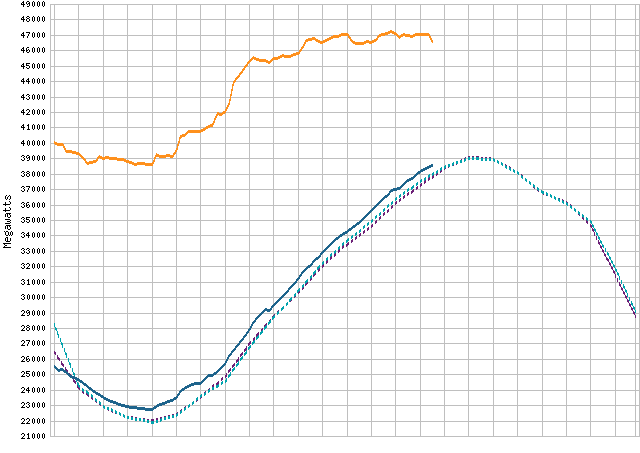

To illustrate how uniform this phenomenon is, here is today's data for Ontario, Canada:
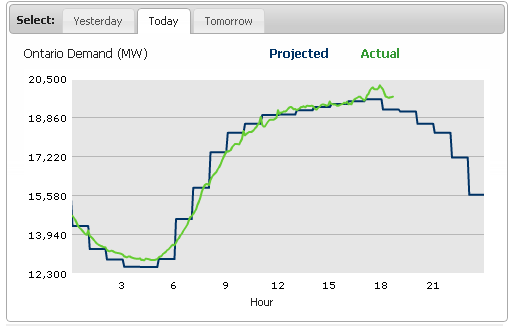
(Wow- the whole of Ontario uses less power than we Californians. We're #1)
Now, a bit of background on how power generation is managed:
There are essentially two classes of power generation, excluding the "unreliable" sources such as wind and solar:
Baseload plants are the heavy-iron of the industry. These are the "big" plants with outputs rated in Gigawatts, which have a high fixed cost, but also a high availability and a low marginal cost. (eg: they cost a lot to build, but very little to run.) Nuke plants, coal plants, hydro plants, stuff like that. These plants typically run 24 hours a day at full output, and are not typically throttled down except for maintenance.
There's enough baseline capacity on the grid to fulfill the entire demand when demand is low. But during the higher-demand periods, the baseload plants aren't enough. That's where "peak demand" plants come into play.
Peakers are typically smaller plants which have either a high marginal cost or are incapable of being run continuously. Gas turbine plants fall into the former category (gas is expensive), while some hydro plants fall into the latter, either because they rely on water which has to be pumped up to a higher elevation during low-demand periods (using baseload energy to do so) or because they drain their reservoir faster than it can be replenished on a continuous basis.
There's not enough grid capacity for everyone to charge up during the day when demand is already high. So, sorry, but those trendy little public charging stations are non-sustainable.
There is, however, enough grid capacity for everyone to charge up at night. And in many areas, electrical power is actually cheaper at night, even for residential service. Any why wouldn't it be? The power is cheaper to make, since it's all coming from the plants that are cheap to run.
So even in the short-term, we have enough installed capacity to support overnight charging of a large number of EVs.
The problem, of course, goes back to the load curve. As more and more EVs start plugging in at night, that load curve is going to flatten out. We will find ourselves in a situation where our baseload capacity is no longer sufficient to supply the base load. This isn't going to cause blackouts or anything, it just means that the peakers will be running more and more, which is especially troublesome in light of the fact that most of them burn natural gas.
So there will be a transitional period in which overnight electrical rates rise, probably towards parity with daytime rates.
This is not a bad thing!
As soon as the load curve flattens, the concept of peak load will start to go away. It will become economically justifiable to build more nukes to supply our increasing base-load requirement, with the consequence that those periods which used to be considered peak hours will become more average. The baseload capacity which we install to cover the increasing overnight demand will also displace the requirement for having as much peak-generating capacity, so the overall trend will be towards less and less use of natural gas, less CO2 and other emissions, and cheaper electricity on the whole.
I can deal with that.
A thought regarding pedaling to work. How many of you have shower/changing rooms/lockers at work? I break into a sweat just looking at my bike.
In the afternoon, I take over, since I'm headed towards a shower anyway.
#30
Boost Pope


Thread Starter
iTrader: (8)
Join Date: Sep 2005
Location: Chicago. (The less-murder part.)
Posts: 33,020
Total Cats: 6,588
This is the sort of thing which really annoys me:
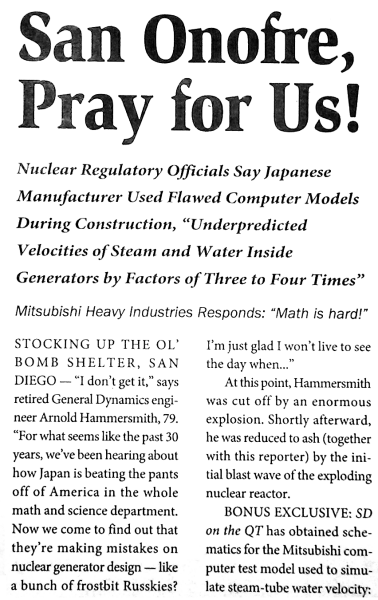
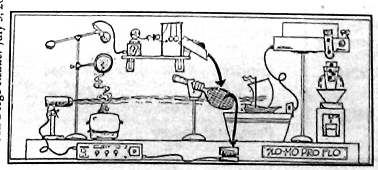
That was printed in the San Diego Reader, which is one of those magazines that's distributed free, and contains an odd mix of well-written stories of community interest, listings of crappy concerts, and advertisements for medical marijuana.
For those who don't know, the San Onofre plant has been offline since nearly the beginning of the year. A couple of years ago they replaced the steam generators (heat exchangers which take primary water from the core and use it to boil secondary water which will turn the turbines) and as it turns out, Mitsubishi sold us a set of defective boilers.
Well, as an engineer I can attest that sometimes, stuff like that just happens.
But the way this article is written... What planet are these guys living on?


That was printed in the San Diego Reader, which is one of those magazines that's distributed free, and contains an odd mix of well-written stories of community interest, listings of crappy concerts, and advertisements for medical marijuana.
For those who don't know, the San Onofre plant has been offline since nearly the beginning of the year. A couple of years ago they replaced the steam generators (heat exchangers which take primary water from the core and use it to boil secondary water which will turn the turbines) and as it turns out, Mitsubishi sold us a set of defective boilers.
Well, as an engineer I can attest that sometimes, stuff like that just happens.
But the way this article is written... What planet are these guys living on?
#33
It's a bit of a ludicrous example, but a couple of years ago Top Gear did an economy test in which they put both a Prius and BMW M3 onto the test track and ran ten laps. The Prius was driven in typical fashion as though it were being used to set a laptime, while the M3 was driven behind it at precisely the same speed- matching the Prius' performance exactly without overtaking it. The Prius returned 14.3 US MPG, while the M3 delivered 16.1 MPG.
#34
Boost Pope


Thread Starter
iTrader: (8)
Join Date: Sep 2005
Location: Chicago. (The less-murder part.)
Posts: 33,020
Total Cats: 6,588
- Release radiation into the atmosphere,
- Deprive the reactor of cooling, or
- Cause anything that could even be remotely construed as a catastrophe.
The fact of the matter is that over the 50 years or so that we've been generating commercial nuclear power, we've had a total of three really major failures. THREE.
One of them caused virtually no damage at all.
One of them was caused by a tidal wave bigger than Pusha's ego, and caused less than one-fifteenth the loss of life as the actual wave itself.
And one occurred in a Soviet reactor that was about as poorly designed as can be imaged, had no containment of any kind, and still caused less than one-third the number of fatalities (including all latent cancers projected out for 30 years) as cars do in the US alone in a single year.
Perspective, bitches. Learn it.
By the same token, gonorrhea is one of the least bad of the venereal diseases.
#35
Elite Member
iTrader: (11)
Join Date: Jun 2007
Location: Overland Park, Kansas
Posts: 5,360
Total Cats: 43
Wat?! You mean to say that some random wrong switch thrown on a console to the likes of which I've never seen won't cause some catastrophic event which results in this:
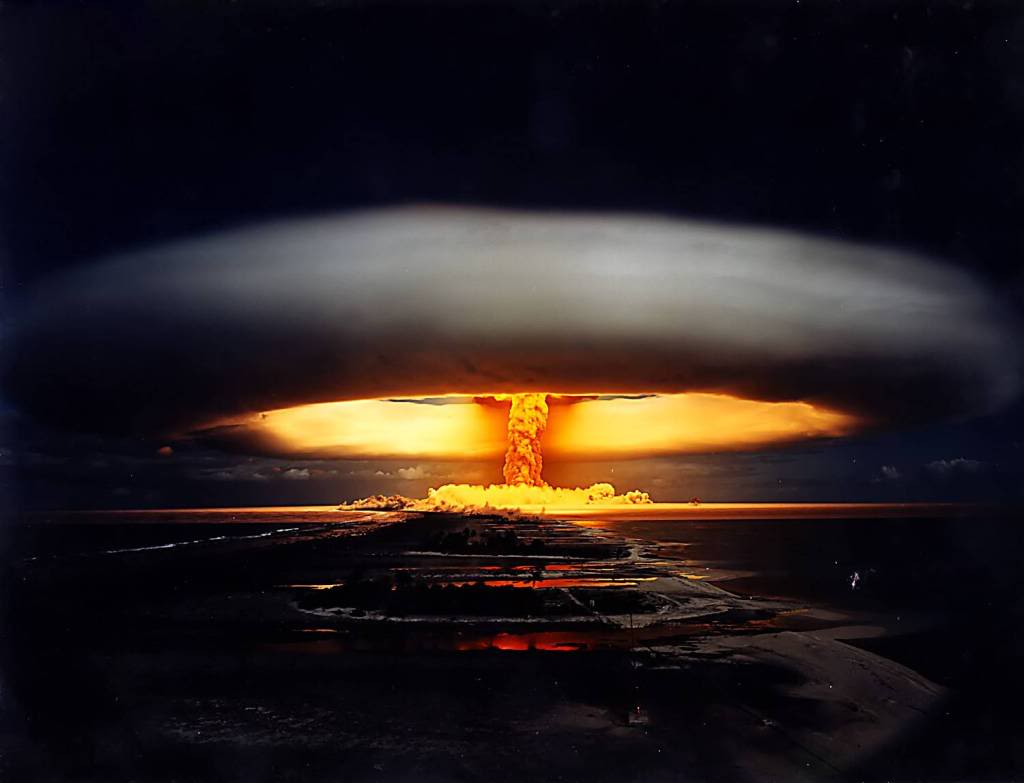
</Sarcasm>
Syphilis is no clapping matter, Joe...

</Sarcasm>
Syphilis is no clapping matter, Joe...
#36
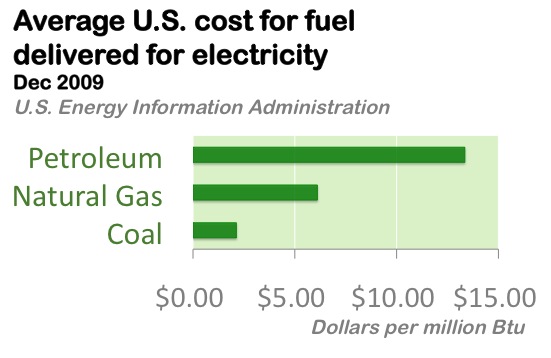
Yes, Natural gas looks like it is indeed the second least expensive fossil fuel.
Im'a throw this graph up here too, just for ***** and giggles:
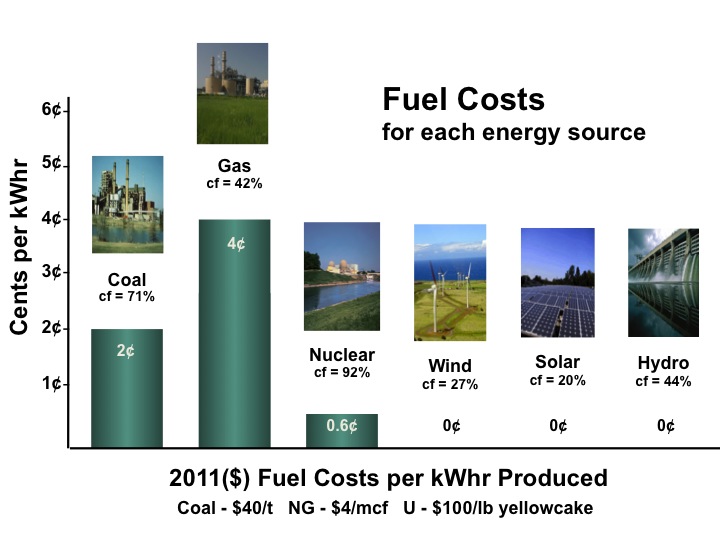
And it's definitely the cleanest burning fossil fuel:
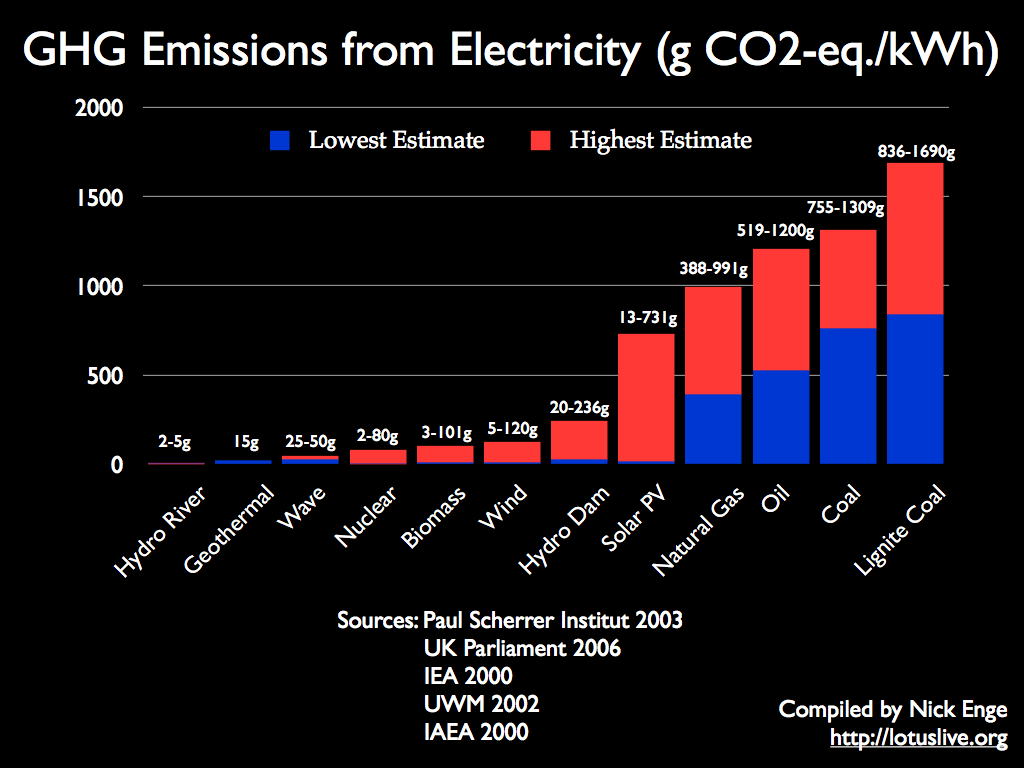
Will you make out with me?

I'm not sure there's really any hate for natural gas, it's fantastic as a peak load fuel, but American's aren't willing to justify paying the difference in price vs. coal for the reduction in pollution right now.
I'm also still of the opinion that energy costs were/are the sole catalyst for our current economic situation. Government didn't necessarily put us here, they're just doing everything in their power to keep us here.
#37
Elite Member
iTrader: (2)
Join Date: Sep 2008
Location: Central Florida
Posts: 2,799
Total Cats: 179
Also, there has been a significant switch from coal to natural gas over the past couple of years. EIA data showed a new record in coal-to-gas switching in April of 2012 and natural gas now makes up a higher percentage of power generation than (I believe) it ever has.
I'll try to find the numbers, but it is getting close to parity with coal.
Last edited by Scrappy Jack; 07-11-2012 at 10:01 AM.
#38
Elite Member
iTrader: (2)
Join Date: Sep 2008
Location: Central Florida
Posts: 2,799
Total Cats: 179
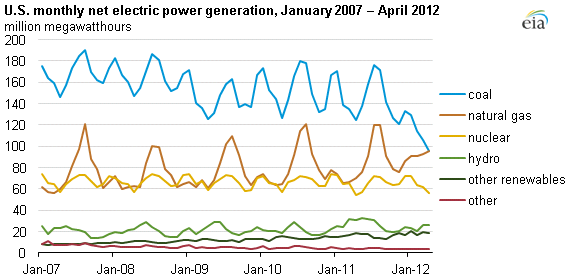
They just hit parity.
Recently published electric power data show that, for the first time since EIA began collecting the data, generation from natural gas-fired plants is virtually equal to generation from coal-fired plants, with each fuel providing 32% of total generation. In April 2012, preliminary data show net electric generation from natural gas was 95.9 million megawatthours, only slightly below generation from coal, at 96.0 million megawatthours.





